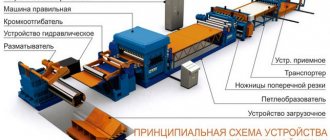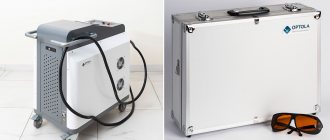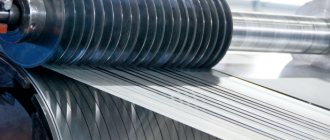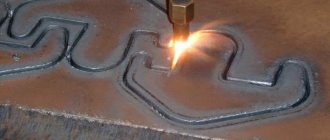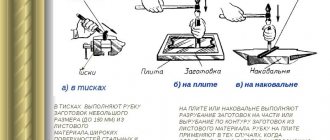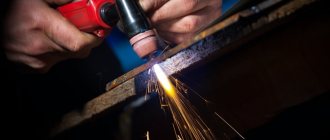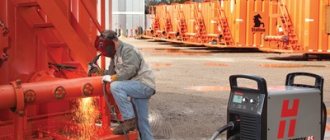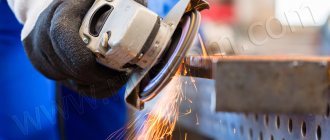Processing metals of various levels of hardness with high precision is possible using unconventional methods. These include cutting, grinding and strengthening the surface using electrical erosion. The electroerosive machine was invented quite a long time ago, but has become widespread only in recent decades.
The first industrial-grade machine was created by CHARMILLES TECHNOLOGIES in 1952, and the CNC EDM machine appeared in 1969. Compared to traditional methods of metal processing - forging, casting, grinding, milling, the electric spark method can be considered innovative. The first mentions of forged and cast products are several thousand years old.
Limits of application of electrical discharge machining
All metals are conductive substances, so electrical discharge machining is applicable to all types of alloys. With its help you can perform a wide range of work, ranging from ordinary cutting and drilling to:
- fine grinding;
- increasing the surface and restoring the configuration;
- hardening;
- copying;
- firmware;
- engraving;
- spraying.
Electroerosive equipment is based on the principle of the occurrence of a short-term electric arc, which leads to the loss of substance by the cathode and anode. With a short pulse, the substance is removed from the anode; with a longer pulse, the substance is removed from the cathode. Modern electroerosive machines use both types of pulses in their work. Both the working tool and the workpiece can be connected to the positive or negative pole.
EDM Capabilities
The only condition that is observed in all types of machines is that only direct current is used. The voltage level and current strength depend solely on the parameters of the metal being processed. The frequency of occurrence of pulses is determined by the mechanical approach and distance of the electrode and the working surface - breakdown occurs only at a certain distance between the contact surfaces.
Electric pulse processing of metals aimed at destroying the workpiece (cutting or drilling) is carried out in a dielectric medium, which is a special liquid. The most commonly used are oil, kerosene or distilled water. Surfacing, strengthening or spraying operations are performed in air or vacuum.
What are the different methods for cutting metal?
There are three main methods of metal processing:
- cutting,
- cutting,
- punching
Technologies differ from each other in various parameters - equipment used, processing accuracy, feed speed. Cutting metal on a guillotine https://www.claser.ru/gilcut.html is one of the most popular techniques. After it, the edges of the product are smooth and neat. Let's discuss it and other methods.
| Processing type | Description |
| Manual cutting | A sharpened chisel and hammer are used, the simplest method. |
| Instrumental and semi-automatic | Special tools are used - saws, scissors. A person applies markings and then cuts the workpiece. |
| Guillotine | The technology is old but effective. The job is simple. |
Cutting and chopping metals using special machines is an ideal way to process various workpieces. The result is a finished product with a minimum level of deformation.
Electrical discharge cutting of metal
This type of processing is used in cases where it is necessary to produce small-sized parts with complex contours with high precision edges, to produce parts from particularly hard alloys, and in jewelry.
Limitations on the size of workpieces and the thickness of the processed material are determined only by the design of a particular machine. In most cases, electrical discharge cutting is used in industrial enterprises focused on large-scale production of high-precision parts that do not require further processing. But without much difficulty, you can build an electrical discharge machine with your own hands, if you have some metalworking skills and a certain knowledge of electronics and electrical engineering. The design of a homemade electrical discharge cutting machine is simple and can be implemented even at home, not to mention in a metalworking workshop or workshop of a small enterprise.
But it should be taken into account that in home-made machines it is very difficult to realize the main advantages of electrical discharge machining - high accuracy and versatility. Refractory metals and alloys are cut very slowly and require high power consumption.
When cutting metal, the workpiece is connected to the positive pole of the current source, and the working electrode is connected to the negative pole. The loss of substance at the anode is nothing more than erosion, a cut, the thickness of which depends on the geometry of the cathode. The type of dielectric with which a certain type of EDM machine works also plays a big role.
For industrial production, two main types of equipment are used - wire EDM (cutting) and EDM piercing machine. The first type is used when processing large parts made of thick-walled metal, the second - for more precise work on copying parts made of high-strength materials or strict requirements for their shape.
Technological indicators
An electric spark installation, depending on the operating mode, can ensure the accuracy of the result within a wide range. If high performance is required with relatively low requirements for surface condition (class I and II), then currents of 10-60 A are used at voltages up to 220V. In this case, electric spark erosion can remove metal from the cutting or drilling zone in a volume of up to 300 mm3/min. With higher accuracy class values - VI and VII, productivity decreases to 20-30 mm3/min, but lower currents are required, no more than 1 A at voltages up to 40 V.
Such a wide range of adjustments shows that electric spark processing of metal can be used in various fields, both for the production of large series of parts and for one-time work, including jewelry.
A feature of the use of electric spark installations can be considered the ability to strengthen parts of various configurations. A thin layer of a stronger alloy or metal is applied to the surface of the workpiece without heating the base to a greater depth. This allows you to preserve the metal structure of the base product and significantly change the properties of its surface. In some cases, base viscosity and high surface hardness are required, or vice versa. Only an electric spark machine can solve this problem.
Wire cutting machines
The electroerosive industrial wire-cutting machine operates on the non-contact principle of interaction between a conductive wire (molybdenum, tungsten or other refractory metal) with a diameter of 0.1-0.2 mm and the workpiece.
You can process metal of any level of refractoriness in different thicknesses of the part. A positive pole is connected to the wire wound on rotating drums, which moves in two directions - vertically and towards the workpiece, and a negative pole is connected to the workpiece. As the wire line moves, a discharge occurs that burns a line of the required configuration into the part. In essence, electrical discharge machining on a wire machine performs milling operations, but on metals of special strength and with precision that is unattainable with mechanical processing. This includes:
- ultra-small angles;
- rounding of microdiameters;
- maintaining parallelism of lines throughout the entire depth;
- high precision edge surfaces.
The processing accuracy reaches 0.110-0.012 mm.
Advantages and disadvantages
Any method has its strengths and weaknesses . Main advantages of the technology:
- Arbitrary shape of the tool, the ability to create closed channels and cavities.
- Allows you to work with any conductive material.
- High degree of automation, low probability of defects due to the human factor.
- Precision processing and improved quality of the resulting surface compared to mechanical methods.
For all its advantages, the method also has very serious disadvantages. The two main disadvantages are:
- Low speed electrical discharge machining. In modern machines, the tool movement speed does not exceed 10 mm per second.
- Very high power consumption.
In terms of all its parameters, electroerosion is superior to many traditional metalworking methods, and in some cases has no alternative. Today, the scope of use of electrical erosion is very extensive.
Electroerosive piercing machines
Electric contact piercing processing of metals involves the action of a point electrode with a given cross-sectional shape, on which the shape of the erosion depression in the workpiece depends. They are used for processing:
- stainless steels;
- tool alloys;
- titanium;
- hardened steel.
But they can work with all types of conductive materials when it is necessary to make holes or recesses of great depth with a minimum diameter and precise cross-section geometry.
One of the most difficult operations of a piercing machine is the production of threaded holes in high-strength, refractory materials. In this case, only CNC machines are used. An electrode made of thin wire is inserted into the hole and moves in the longitudinal and transverse directions (along the X, Y axes, with simultaneous movement along the Z axis). The result is a hole with a complex wall configuration, threaded or other profile.
Electrical contact processing allows you to obtain high-precision impressions of stamps, molds or other small parts. In this case, the electrode is a miniature copy of the required product, made of copper or graphite. Depending on the polarity of the connection, clear depressions or equally clear protrusions are obtained on the workpiece. Such electroerosive machines are produced in both stationary and desktop versions (for example, G11 ARAMIS (Czech Republic)).
Electric spark machine diagram
Metal processing by the electric spark method is very common, so it is very difficult to consider all types of equipment and models of specific installations. They are all united by common structural elements:
- DC source;
- capacitor;
- vibrator;
- mode switch.
A design operating in an electric spark mode may differ in a number of characteristics that allow it to work with a particular material, but the general principles of constructing a working circuit are the same.
The battery of capacitors is coordinated with the mechanical movement of the electrode, the discharge occurs at the moment of maximum approach of the working surfaces. Relaxation pulse generators determine the maximum charge of the capacitor at the maximum amplitude of deviation from the approach point. After the spark discharge, the capacitor has time to charge fully.
Why do you need to move the wire during EDM cutting?
What is a load fork
This is a battery testing device. It does not check all the parameters of the battery, but it allows you to obtain enough information about the condition of the battery so that you can come to your senses in time and replace this important component of any car. It is possible to purchase a product, including a digital plug, or you can make a load plug yourself.
Design
This is what the load fork consists of:
- two terminals with wires connected to them;
- the required resistance in the form of a spiral or resistors;
- voltmeter.
There are products of different shapes:
- classic (in the form of a dinner fork);
- with two wires and two terminals;
- with one wire and one spike.
Anything will do, but it has its own specifics. If the option with a wire and a spike is used, then, accordingly, look for a terminal on the battery for the spike. Many people prefer to have two terminals. But there is no fundamental difference here. Even a homemade load fork is suitable for testing.
Why check the battery with a fork?
It is especially important to do this for those who buy a car second-hand. But do not forget that the test should be at room temperature (20 to 25 degrees). The car must be warmed up; you cannot check the battery of a car that has just been standing in the cold for a long time.
However, even if we are talking about a completely new battery, it is worth checking it sometimes using a load fork. This will give you an idea of:
- battery charge level;
- the need for desulfation or lack thereof;
- overall condition of the battery.
Non-standard solution to the issue
In this case, the load fork is made in an even more interesting way, using a sewer pipe carefully cut in the longitudinal direction.
Here is a diagram of the plug design, designed to test the resistance indicators of 12-volt batteries with a capacity of several tens of ampere-hours:
- constant wire , 12 turns with an internal winding diameter of 38 mm;
- M8 studs are welded to the ends of the wire ;
- all this can fit perfectly into a sewer pipe if its diameter is 50 mm ;
- the gap is closed with a second piece of the same pipe;
- are installed on the sides , and the structure is ready.
This is interesting: What is good about the delkor battery?
Technical parameters: resistance value is about 0.1 Ohm , current at a voltage of 12 volts is from 110 to 120 amperes . The duration of the load in this case should be minimal, no more than 3-5 seconds (unfortunately, the device heats up very quickly). All battery indicators are measured in the same way, using a voltmeter of any type. When creating such a plug, it is recommended to use the table for calculating the resistance of wires of various lengths.
How to check correctly
Now you will learn how to test the battery with a load fork. This is an important skill because it allows you to get almost all the necessary information about the battery. There is nothing difficult about checking the battery with a load fork. Everything is done according to the instructions. There is no need to remove the batteries for this procedure. The fork can even be placed under the hood. Fortunately, this testing device is not large. Before taking measurements, check the circuit for leaks. Also inspect the battery visually. That's why it's also important to know how to test a battery without a load plug. When checking, do not leave both devices unattended.
The battery does not hold the load, what should I do?
When checking with a load fork, the voltage on the battery should “sag”, after which it begins to rise.
Read also: Generator for three-phase network
If this does not happen, and the battery does not hold the load (the voltage continues to decrease), we can conclude that the device has failed and needs to be replaced.
The rechargeable battery (AB) provides power to the electrical systems and devices of the vehicle. If the battery is not maintained promptly, its life may be significantly reduced. The maintenance schedule includes periodically checking the condition of the battery with a load fork. The plug allows you to check the state of charge of the battery, i.e. completeness of charge or depth of discharge. Load forks have a variety of designs, but all of them allow you to check the performance and condition of the battery.
Under load
Here's how to use the load fork:
- Connect the plug to the battery.
- The fork forms the load. The latter lasts from five to six seconds.
- They receive readings and record them.
- Check the data in the table with battery standards.
- They draw conclusions.
As a result, it becomes clear whether it is possible to continue using the battery, or whether a new one is needed.
DIY battery load fork
Today there are different models for testing car batteries. However, if you want to save money and craft, it is possible to make such a fork yourself. Products made by handicraft are inferior in appearance to industrial ones, but not in functionality.
Here's how to make a load fork:
- Take a spiral. It could be a coil from an old electric stove, or something else. An avid motorist should rummage around in the garage; he'll probably find something. Or, if there is nothing like that there, perhaps there is unnecessary equipment in the house that can be disassembled for such a reason.
- Such a part is rolled into several layers, that is, wire strands. This is done in order to achieve a resistance of 0.1 - 0.15 Ohms. The result is a sort of small element of resistance, but it must be properly connected to other parts of the device, otherwise it will be useless.
- Now you will need a 21 Watt car light bulb (for example, from turn signals). You will also need a battery up to 15 Volts. The result is a homemade resistance. The latter is either secured with a nut and screw, or soldered. Add a multimeter with a range of 10 Amps. The regular version from the store will do. The main thing is to be confident in the functionality of the device. The latter determines whether it will be possible to assemble a working fork capable of giving accurate readings. And the owner’s awareness of the condition of the battery and, possibly, safety on the road will depend on these readings.
- Now the entire chain is assembled. The connection is made in series.
- Attach the clamps to the terminals of the car battery.
- They look at the multimeter and get readings. It should be around 1.78 Amps.
- The multimeter is removed.
- Reconnect the entire circuit.
- Measure the voltage on the spiral. It should be about 197 millivolts.
- Calculate resistance using Ohm's law. The voltage is divided by the current, and you get about 0.11 ohms (if the numbers are the same as above).
- Now the plug is connected to the battery for about five seconds. First connect the multimeter. A direct current of 20 Volts is supplied.
- All that remains is to take readings and draw conclusions.
Classification of methods
There are the following methods of electrical discharge machining of workpieces:
- Combined method – involves the use of several methods of influence at once. Some equipment allows you to combine mechanical and electrical discharge machining. This method has been quite popular lately, as it makes it possible to achieve high results.
- EECHO or electroerosive chemical grinding is a method of influence that involves combining the method of supplying current and electrolyte. The method is quite popular; it allows you to improve the quality of the surface and change the shape of the workpiece.
- Abrasive with the supply of electric current allows you to influence the workpiece to change the roughness. In this case, the equipment is intended solely to obtain a certain roughness.
- The anodic-mechanical effect is determined by the fact that the process occurs in a liquid medium. In this case, after applying current, a film appears on the surface, which is subsequently removed mechanically.
- Electroerosive hardening by electrical treatment is characterized by the fact that the equipment used can significantly increase the strength of the surface layer. The procedure does not take much time and is easy to perform.
- Volumetric copying - the equipment in this case has a tool of a certain shape and size, which is reflected on the workpiece when current is applied.
- Stitching is a method of electrical influence in which a hole of a certain diameter and shape is formed.
- Marking is carried out by applying certain information that remains for a long time. This marking is easy to implement and less expensive.
- Electrical discharge cutting is carried out quite often. It differs in that it is possible to obtain high-precision dimensions by cutting using this method.
- Sanding is also done quite often.
Diagram of a wire-cut electrical discharge machine
The above points determine that electrical discharge machining of metals makes it possible to obtain a workpiece with the most suitable characteristics.
Technology Basics
The features that electrical discharge machining has include the following:
- One of the electrodes is the workpiece, the other is the electrode-tool.
- The discharge is applied periodically, in the form of short pulses, since such an effect allows the electrical strength of the medium between the electrodes to be restored.
- Unipolar pulses are supplied in order to reduce wear on the instrument electrode used.
- An important point is how long the impulse lasts. With a short duration of the applied pulse, the wear of the anode increases significantly. However, with a long pulse duration, cathode wear increases significantly.
Scheme of electrical discharge processing method
Often in practice, the method of connecting to the positive and negative plus of the alternator is used.
Scheme 2
Additional options
The buyer of an EDM machine can retrofit the equipment with the following options:
- Controlled position of the C axis. More often required for milling cylindrical workpieces.
- Turret head with additional degrees of tool freedom. Using this model, geometrically complex parts are obtained.
- The table may have additional axes. This option is used when processing cabinet products or several workpieces in one cycle.
The standard equipment includes working fluid purification systems that allow filtration with a quality of up to 3 microns. Contaminated cartridges have standard sizes and are replaced quite quickly.
Processing metals of various levels of hardness with high precision is possible using unconventional methods. These include cutting, grinding and strengthening the surface using electrical erosion. The electroerosive machine was invented quite a long time ago, but has become widespread only in recent decades.
Equipment capabilities
The use of electrical erosion equipment is more effective than traditional mechanical methods of processing materials. The wide range of precision machining capabilities of superhard alloys and the high variability of tools make it possible to produce parts at a level of quality and complexity inaccessible to traditional machine tools.
Electroerosive machines make it possible to process parts with minimal internal radii and produce high-precision dies without further finishing adjustment. The need to carry out intermediate heat treatment operations on the workpiece has disappeared; the equipment allows for adjustment and grinding of mating parts.
Wire EDM cutting can separate high-strength metals and complex contours more efficiently than mechanical machines. The processing speed, the parallelism of the cutting lines throughout the entire depth of the workpiece being processed, and the high precision of the edge line make electroerosive machines indispensable when working with superhard materials.
CNC machines provide high precision, speed and productivity. Electric spark hardening makes it possible to increase the hardness of the machined surface of the part, thereby significantly increasing its wear resistance after formation and processing.
